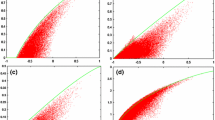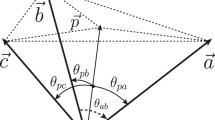Abstract
Nonlocality is a distinctive feature of quantum theory, which has been extensively studied for decades. It is found that the uncertainty principle determines the nonlocality of quantum mechanics. Here we show that various degrees of nonlocalities in correlated system can be characterized by the generalized uncertainty principle, by which the complementarity is attributed to the mutual dependence of observables. Concrete examples for different kinds of nonclassical phenomena pertaining to different orders of dependence are presented. We obtain the third-order “skewness nonlocality” and find that the Bell nonlocality turns out to be merely the second-order “variance nonlocality” and the fourth-order dependence contains the commutator squares, which hence is related to the quantum contextuality. More applications of the generalized uncertainty principle are expected.



Similar content being viewed by others
References
Heisenberg, W.: Über den anschaulichen Inhalt der quantentheoretischen Kinematik und Mechanik. Z. Phys. 43, 172–198 (1927)
Einstein, A., Podolsky, B., Rosen, N.: Can quantum-mechanical description of physical reality be considered complete? Phys. Rev. 47, 777–780 (1935)
Bell, J.S.: On the Einstein–Podolsky–Rosen paradox. Physics 1, 195–200 (1964)
Clauser, J.F., Horne, M.A., Shimony, A., Holt, R.A.: Proposed experiment to test local hidden-variable theories. Phys. Rev. Lett. 23, 880–884 (1969)
Cirel’son, B.S.: Quantum generalization of Bell’s inequality. Lett. Math. Phys. 4, 93–100 (1980)
Popescu, S., Rohrlich, D.: Quantum nonlocality as an axiom. Found. Phys. 24, 379–385 (1994)
van Dam, W.: Implausible consequences of superstrong nonlocality. arXiv:quant-ph/0501159
Buhrman, H., Cleve, R., Massar, S., de Wolf, R.: Nonlocality and communication complexity. Rev. Mod. Phys. 82, 665–698 (2010)
Pawłowski, M., Paterek, T., Kaszlikowski, D., Scarani, V., Winter, A., Żukowski, M.: Information causality as a physical principle. Nature 461, 1101–1104 (2009)
Rohrlich, D.: PR-box correlations have no classical limit. In: Struppa, D.C., Tollaksen, J.M. (eds.) Quantum Theory: A Two-Time Success Story (Yakir Aharonov Festschrift), pp. 205–211. Springer, New York (2013)
Kochen, S., Specker, E.P.: The problem of hidden variables in quantum mechanics. J. Math. Mech. 17, 59–87 (1967)
Cabello, A.: Bell non-locality and Kochen–Specker contextuality: how are they connected? arXiv:1904.05306
Araújo, M., Quintino, M.T., Budroni, C., Cunha, M.T., Cabello, A.: All noncontextuality inequalities for the n-cycle scenario. Phys. Rev. A 88, 022118 (2013)
Khrennikov, A.: Contextuality versus incompatibility: searching for physical meaning of contextuality peeled off incompatibility. arXiv:2005.05124
Ekert, A.K.: Quantum cryptography based on Bell’s theorem. Phys. Rev. Lett. 67, 661–663 (1991)
Howard, M., Wallman, J., Veitch, V., Emerson, J.: Contextuality supplies the ‘magic’ for quantum computation. Nature (London) 510, 351–355 (2014)
Oppenheim, J., Wehner, S.: The uncertainty principle determines the nonlocality of quantum mechanics. Science 330, 1072–1074 (2010)
Li, J.-L., Qiao, C.-F.: The generalized uncertainty principle. Ann. Phys. (Berl.) 335, 2000335 (2021)
Fulton, W.: Eigenvalues, invariant factors, highest weights, and Schubert calculus. Bull. Am. Math. Soc. 37, 209–249 (2000)
Li, J.-L., Qiao, C.-F.: A necessary and sufficient criterion for the separability of quantum state. Sci. Rep. 8, 1442 (2018)
Li, J.-L., Qiao, C.-F.: The optimal uncertainty relations. Ann. Phys. (Berl.) 531, 1900143 (2019)
Pusey, M.F.: Negativity and steering: a stronger Peres conjecture. Phys. Rev. A 88, 032313 (2013)
Li, J.-L., Qiao, C.-F.: Characterizing quantum nonlocalities per uncertainty relation. Quantum Inf. Process. 20, 109 (2021)
Leggett, A.J.: Nonlocal hidden-variable theories and quantum mechanics: an incompatible theorem. Found. Phys. 33, 1469–1493 (2003)
Stuart, A., Ord, J.K.: Kendall’s Advanced Theory of Statistics, Vol 1: Distribution Theory, 6th edn. Wiley, Weinheim (2010)
Fine, A.: Hidden variables, joint probability, and the Bell inequalities. Phys. Rev. Lett. 48, 291–295 (1982)
Landau, L.J.: On the violation of Bell’s inequality in quantum theory. Phys. Lett. A 120, 54–56 (1987)
Egozcue, M., García, L.F., Wong, W.-K., Zitikis, R.: The smallest upper bound for the \(p\)th absolute central moment of a class of random variables. Math. Sci. 37, 125–131 (2012)
Mermin, N.D.: Hidden variables and the two theorems of John Bell. Rev. Mod. Phys. 65, 803–815 (1993)
Jahnke, V.: Recent developments in the holographic description of quantum chaos. Adv. High Energy Phys. 9632708 (2019)
Acknowledgements
This work was supported in part by the National Natural Science Foundation of China (NSFC) under the Grants 11975236 and 12235008 and by the University of Chinese Academy of Sciences (Grant No. E1E40206X2).
Author information
Authors and Affiliations
Contributions
All authors have equally contributed to the main result, the examples and the writing. All authors have given approval for the final version of the manuscript.
Corresponding author
Ethics declarations
Conflict of interest
The authors declare no competing interests.
Additional information
Publisher's Note
Springer Nature remains neutral with regard to jurisdictional claims in published maps and institutional affiliations.
Supplementary Information
Below is the link to the electronic supplementary material.
Rights and permissions
Springer Nature or its licensor (e.g. a society or other partner) holds exclusive rights to this article under a publishing agreement with the author(s) or other rightsholder(s); author self-archiving of the accepted manuscript version of this article is solely governed by the terms of such publishing agreement and applicable law.
About this article
Cite this article
Yang, MC., Li, JL. & Qiao, CF. An effective way of characterizing the quantum nonlocality. Quantum Inf Process 22, 242 (2023). https://doi.org/10.1007/s11128-023-04003-3
Received:
Accepted:
Published:
DOI: https://doi.org/10.1007/s11128-023-04003-3




